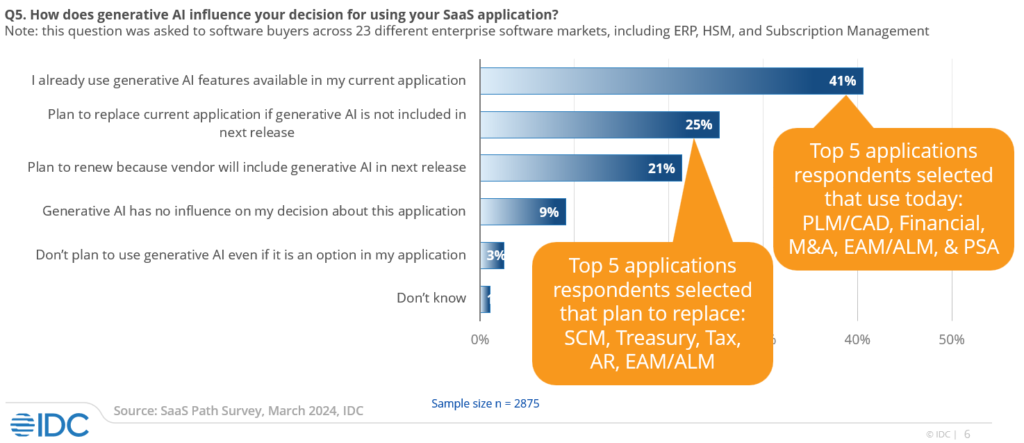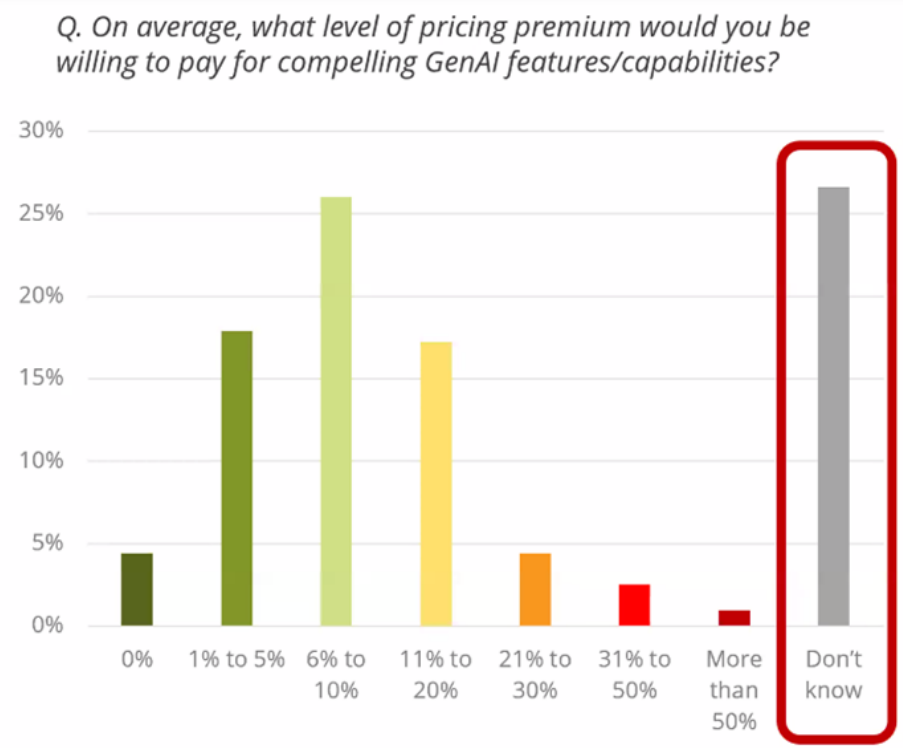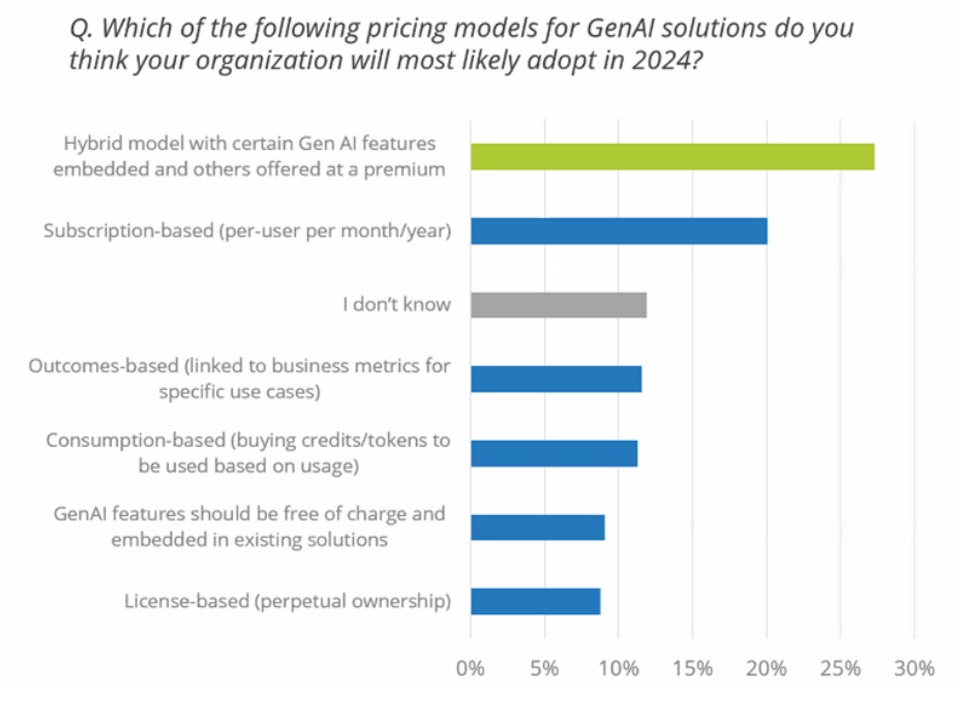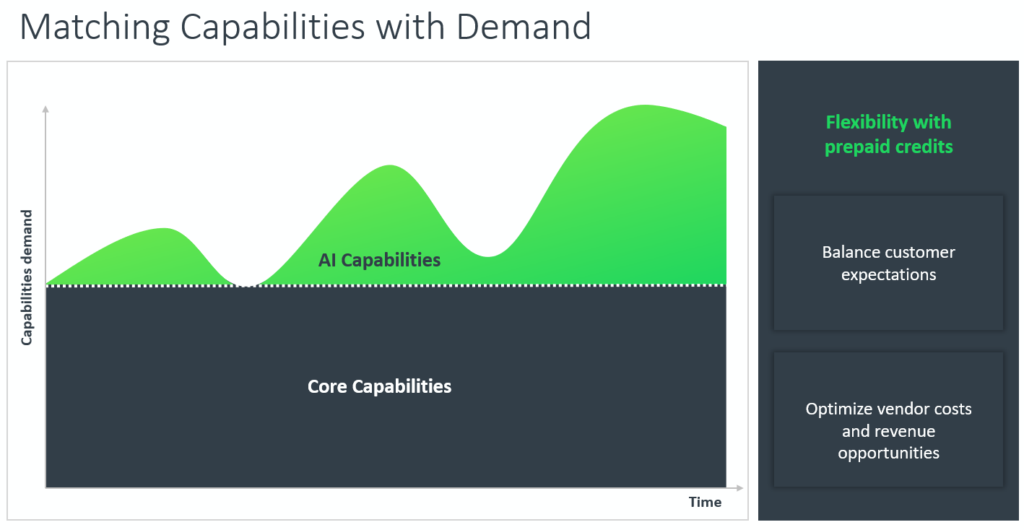As artificial intelligence transforms industries and redefines expectations, the question of how to monetize AI has become critical for software producers.
While developing AI functionality requires significant investment, getting it right can unlock new sales opportunities and boost customer retention.
During a webinar on Usage-Based Approaches to Monetizing AI, IDC’s Senior Research Director, Mark Thomason, shared findings that indicate 25% of SaaS buyers plan to replace their applications if AI isn’t included in the near future, while only 9% say AI readiness has no impact on decision making.

Additionally, Mark referenced survey data that suggests:
- 39% of buyers believe AI features should be included as part of existing subscriptions/licenses at no extra cost.
- However, 61% understand additional expenses are involved, so they’re willing to pay more.
Demonstrating clear benefits is key to persuading people to commit budget, so this should be a guiding principle as you explore how to monetize AI.
In fact, IDC’s Software Monetization Trends Report states that – after years of hype – artificial intelligence is entering its ‘prove it’ phase as buyers consider how much of a premium they’re willing to pay for compelling AI capabilities.
The jury is out, with “Don’t know” the most common response to the poll, closely followed by modest price increases of between 6% and 10%.

Ultimately, as AI functionality moves from buzzword to business differentiator, producers must focus on delivering measurable value to justify cost, which is why many are implementing usage-based pricing options.
Key Steps to Monetizing AI
Given the rapidly evolving landscape, experimentation is widespread, but when IDC surveyed product leaders on how to monetize AI, hybrid strategies ranked top – with certain features freely available and others charged at a premium.
Subscription, outcome-based, and consumption-based approaches are also popular, suggesting the trend for hybrid software monetization models is set to continue as producers aim to improve flexibility to stay competitive.

When calculating your AI pricing strategy, it’s vital to consider the full picture of how these capabilities align with your overall positioning.
A good rule of thumb is: If your AI functionality adds value independently of your core product, consider packaging it separately – perhaps as an add-on.
For example, many producers are adopting blended models whereby enterprise subscriptions cover day-to-day use of core offerings, while prepaid credits are sold separately to accommodate activity spikes, on-demand access to premium features, or occasional use of different applications within the same portfolio.

This hybrid approach creates more choice, but people want predictability, so it’s advisable to offer a model that ensures a large amount of predictability with an element of variability – perhaps 75% to 25% – so both buyers and suppliers can better forecast costs and revenue.
Bookmark this guide:
How to Sell Software with Pay-As-You-Go Pricing
How to Monetize AI with Usage Data
As you test the waters with new capabilities, it’s common to run beta programs with trusted partners, allowing you to conduct accurate customer data analysis to gain insights into utilization and monetization potential.
Monitoring user activity for meaningful metrics can be challenging, but Revenera’s Dynamic Monetization is an API-driven platform that allows you to introduce flexible monetization models and collect real-time usage data.
You can learn more in this short video:
With its advanced monetization analytics and plug-and-play flexibility, the unique Elastic Access model could be a great option as you examine how to monetize AI, offering the ability to:
- Sell metered tokens (prepaid credits), which can be consumed to access technology items at listed costs.
- Set token prices for each item (e.g., application, feature, capability, digital experience) via rate tables.
- Make immediate price and packaging changes by adjusting the rate tables.
- Provide real-time, granular usage data to ensure precise show-back or charge-back to customers.
The power to share real-time data can ease buyer concerns around cost predictability, reducing the period of uncertainty between action and billing.
These insights can also help refine pricing models, supporting the whole experimental mindset and boosting revenue streams as you navigate your way to profitable AI monetization.
Additionally, the adjustable rate tables provide a flexible method of selling feature consumption as an optional add-on, independent of core product SKUs. This allows producers to simplify, test, and optimize packaging.
Discover more:
Comparing AI Pricing Models and Monetization Strategies
Practical AI Monetization Advice
As the computational costs of generative AI need to be factored in, producers must be agile in their approach.
With its inherent flexibility, token-based monetization can be a great way to monetize AI with real-time usage data that helps substantiate the value customers receive.
A well-rounded strategy balances innovation with customer satisfaction, and usage-based SKUs can empower you to meet diverse user needs while ensuring a sustainable and profitable approach to monetizing AI.
If you’d like further advice on how to monetize AI, please contact Revenera’s experienced team who can talk you through modern approaches to software monetization. Arrange a discovery call today.




